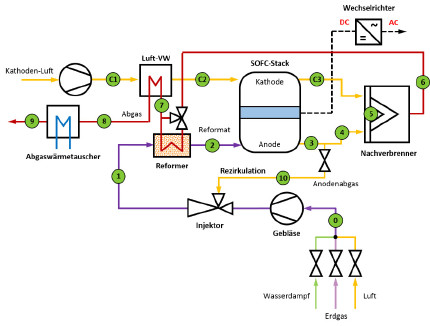SOFC4City – Use of waste heat from fuel cells for buildings and industry
10.4.2018
In the framework of the programme “Stadt der Zukunft” (City of Tomorrow) the University of Applied Sciences Burgenland worked beside other project partners from Austria for one and a half years on the project SOFC4City - Use of waste heat from fuel cells for buildings and industry. The results are very interesting also concerning the use of waste heat.
Due to the high operating temperature of the Solid Oxide Fuel Cell (SOFC) various fuels (natural gas, biogas, hydrogen, methanol, SNG, BtL etc.) could be used. This type of fuel cell also generates waste heat with a high temperature, which could be used for other applications (like district heating, heating for single buildings, etc.)

Scematic of the analysed SOFC system (Heschl et al., 2017)
The results of the project SOFC4City show that the lifecycle of fuel cells essentially depends on their respective heating rate in the start-up and shut-down cycle. High heating rates cause high thermal stresses in the stacks, which lead to high degradation rates. Therefore, SOFC-systems react slowly and cannot meet fast changes in power demand. Hence, an efficient, decentral integration of SOFC-systems requires an optimized overall system configuration with short time storage units which can avoid fast load changes and enhance the demand side flexibility.
For developing of such optimized system configuration, the energy demands of residential buildings were investigated. For that purpose, high-resolution thermal and electrical load profiles were generated for multi-family houses with the simulation tool synPRO and were analyzed with the post-processing tool Matlab. In addition, a CFD-stack model was used to identify the influence of the kinetics of the chemical reactions and the electrochemical losses on the temperature distribution in the stack. The results were used to derive a numerically efficient white-box-model. Based on this white-box-model, different SOFC-system concepts were characterized and the waste heat utilizations on different temperature levels were analyzed.
The results show that SOFC-systems with short time storages can adapt to the electricity and heat demands very well. The use of the electricity grid on district basis allows realizing load balance potentials and decentralized waste heat potentials. Hence, heat distribution losses can be minimized which leads to an efficient energy supply system.
